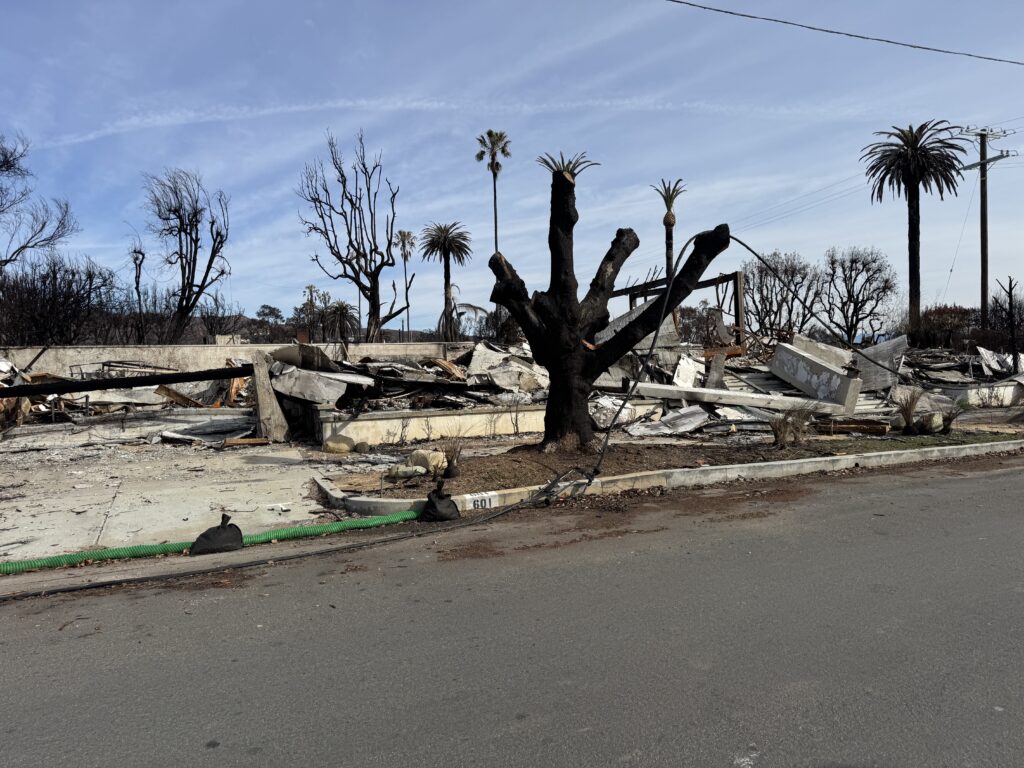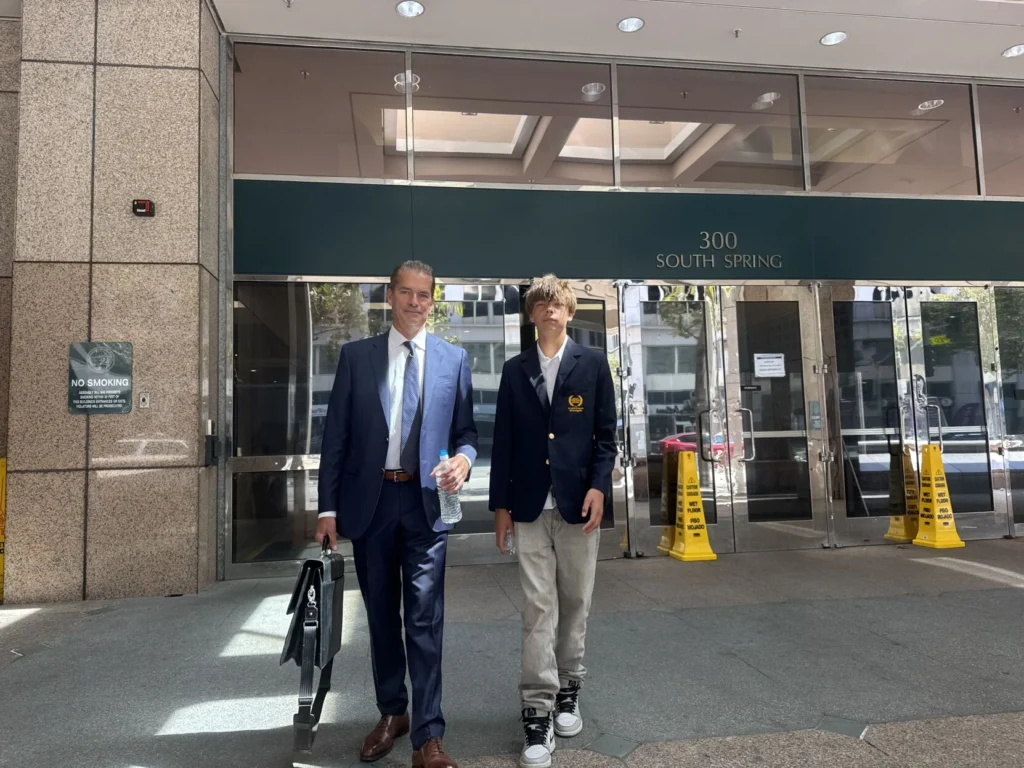
People are still reeling from the complete loss of home and property and are having trouble with insurance companies such as State Farm.
Key technical fights in State Farm’s rate-hike case landed before an administrative judge Wednesday.
The hearing, held inside the Ronald Reagan State Building in downtown Los Angeles, came one day after the judge issued a major ruling rejecting the California Department of Insurance’s request to move all pre-hearing proceedings to a virtual format. It also set the stage for a second decision — a more technical but equally important ruling on whether State Farm’s $1.29 billion rate hike could be fast-tracked while questions about its claims practices were delayed.
Merritt David Farren, a Pacific Palisades wildfire survivor and former lead counsel for Disneyland and Amazon, was in chambers as Judge Karl-Fredric J. Seligman considered procedural matters shaping the next phase of the case.
In a brief, human moment before delving into legal arguments, Farren thanked the judge and acknowledged his high school son seated in the gallery.
Granted intervenor status in July, Farren has emerged as one of the leading voices in the proceedings, representing homeowners affected by the January wildfire while pressing broader concerns about the claims-handling practices of State Farm, California’s largest property insurer. He is preparing to file a comprehensive discovery request by Sept. 2 that could fundamentally reshape the case.
State Farm did not have media representatives in court Wednesday to answer questions. Earlier this year, the company warned that claims from Los Angeles-area wildfires would further strain its finances and could drive it out of California, where it has already canceled or declined to renew tens of thousands of policies.
In May, State Farm won unprecedented approval from the state to impose emergency interim rate increases. During that public hearing, company officials argued that a recent credit downgrade threatened its solvency and, with it, the policies of more than 1 million California homeowners.
Farren’s filing will seek detailed information about how State Farm has managed wildfire-related claims, including payout timelines, estimator training, rebuild cost assessments, and personal property policies. The aim is to determine whether the company has changed its practices since the historical period it relies on to justify higher premiums.
“This is about fairness,” Farren said. “If State Farm can show their practices haven’t changed, fine — their data stands. But if they’ve made it harder for people to rebuild, the data they’re using to justify hikes doesn’t hold up. That’s critical for fire survivors and for everyone who relies on homeowners’ insurance in California.”
Farren believes State Farm is trying to “push aside” the issues he has raised by focusing narrowly on actuarial tables rather than the lived experiences of policyholders. He called that approach insufficient and potentially misleading, as State Farm’s historical loss data, which it claims will predict its future losses, won’t be predictive of its future losses.

Merritt Farren leaves the Ronald Reagan State Building in downtown Los Angeles with his son after a State Farm rate-hike hearing.
Photo: JAMIE PAIGE
Merritt Farren and his son leave the Ronald Reagan State Building in downtown Los Angeles following a State F
Farren’s discovery request will also ask State Farm to provide data comparing wildfire payouts at regular intervals — one month, three months, six months, nine months and a year after disasters — to determine whether survivors today are being compensated differently than in the past. He plans to examine personal property claim policies, which he said have caused confusion and hardship for families.
“We’ve seen cases where State Farm paid out, say, 65 percent of a personal property claim upfront, only to come back months later and claw back part of that payment because the family couldn’t itemize every last belonging,” Farren said. “Other insurers aren’t doing that. We need to know whether that’s a long-standing policy or a new one that makes it harder for survivors to rebuild.”
He also intends to scrutinize how State Farm trains its estimators — the people who assess rebuilding costs after catastrophic losses — and why their initial in-field estimates are sometimes reduced internally without explanation.
“We’ve heard from homeowners who’ve discovered that their preliminary rebuild assessments missed major components, like the number of bathrooms or proper square footage,” he said. “Then we see those estimates lowered even further after they leave the field. On what basis is State Farm reducing estimates provided by its own experts? That’s something we need to get on the record.”
By focusing on these practices, Farren said he hopes to reveal whether State Farm’s historical data — the foundation of its request for sweeping rate hikes — reflects current realities or whether changes in claims handling undermine its justification.
Farren’s participation is unprecedented; he is believed to be the first wildfire survivor to intervene at this level in a rate-setting case and to play such a significant role in shaping how insurance hikes are evaluated.
“This isn’t just about rates,” he said. “It’s about accountability — for insurers, for regulators, and for making sure what happened to Palisades and Altadena families never happens again.”
Tuesday’s Ruling a Win for Transparency
The Wednesday hearing followed a written ruling Judge Seligman issued Tuesday denying the Department of Insurance’s attempt to convert all pre-hearing proceedings to a remote format. The department, supported by State Farm, had argued that policyholder frustrations and safety concerns for its legal team warranted virtual participation.
Consumer Watchdog, the nonprofit representing consumer interests in the case, opposed the motion, warning that shifting proceedings online would “curtail in-person attendance” and “convert a public hearing into a de facto closed session.”
Judge Seligman rejected the request, writing that Proposition 103 — the 1988 voter-approved initiative governing insurance rate-setting — guarantees the public’s right to observe and participate in hearings.
“The in-person format is not merely customary; it is a structural feature of a process designed to ensure the public’s ability to observe, participate, and be heard,” Seligman wrote. “Departures from this format should be approached with caution and justified by compelling circumstances.”
Survivors Call It a ‘Huge Win’
For wildfire survivors, Tuesday’s decision marked a significant victory in their push for accountability.
“Prop 103 is clear — the public has a right to attend these hearings,” said Joy Chen, co-founder of the Eaton Fire Survivors Network who was also in attendance on Tuesday. “The department wanted to push this through under cover of darkness, but the judge upheld the rule of law. This is a huge win for families still fighting to get home.”
Judge Blocks Bid to Split Hearings
Another win for fire survivors came on a more technical but significant point in the case.
Insurance Commissioner Ricardo Lara’s office had sought to “bifurcate” the proceedings — effectively splitting the hearings so State Farm’s proposed $1.29 billion rate hike could move forward while questions about the company’s claims practices were delayed, and potentially never addressed.
Survivors and advocates warned that such a move would allow the company to secure higher rates without first being held accountable for its handling of wildfire claims. Judge Seligman rejected the proposal, siding with those who argued that any consideration of rate increases must include an examination of whether State Farm has complied with the law.
The case is expected to continue with formal evidentiary hearings expected to take place sometime in December in Oakland.

My concern in increasing the rates is I had already been increased by over 70% prior to the fire and the next increase, I won’t be able to afford to stay in my home of 52 years and will have to sell my home. Why can’t the Palisades residents be allowed to talk regarding this case. Those of us with State Farm going through this trauma , we need our voices heard as well. The trauma we have been through and continue to is unbelievable. I am back in my home but still dealing with the insurance piece.
If there is any group that you know of that are also addressing issues, I would like to be involved.
Thank you!
Thank you Mr. Farren for representing the survivors’ concerns.
Thank you for standing up for those of us who lost homes in the January fires and are battling with State Farm. I have had to spend thousands just to get the coverage that I paid for and that State Farm said that I needed in case of a total loss. In my opinion an insurance policy is a contract. I kept up my end by paying my premiums so why doesn’t State Farm have to keep up there end? Why do I have to prove that I need my coverage to rebuild?
Personally I don’t think a rate hike is fair until all of us who lost property in the fires are paid our full policy limits.